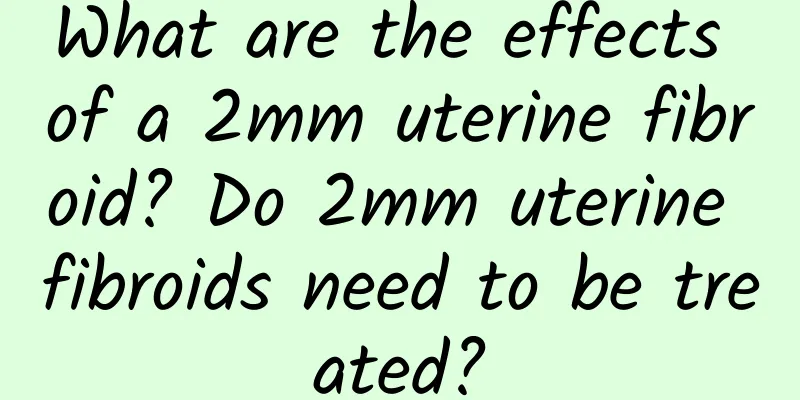What are the effects of a 2mm uterine fibroid? Do 2mm uterine fibroids need to be treated?

|
Uterine fibroids are one of the most common tumors of the female reproductive system. They can grow anywhere in the uterus, including inside and outside the myometrium. Uterine fibroids of different sizes may have different effects on women's physical health. Although 2 mm uterine fibroids are small, they cannot be ignored. So, what are the effects of 2 mm uterine fibroids? Do they need treatment? Let's find out together. Let's answer the first question: What are the effects of a 2 mm uterine fibroid? A 2 mm uterine fibroid is relatively small in size and may not cause noticeable symptoms or affect a woman's daily life. However, this does not mean that it is completely harmless. The main effects of uterine fibroids depend on their location and number. It may cause menstrual problems such as irregular menstruation, prolonged menstruation, and heavy menstrual flow. Some women may experience abdominal pain or a feeling of pressure, especially if the uterine fibroid is located under the endometrium or puts pressure on the uterine wall. Although smaller uterine fibroids are usually benign, they also have the potential to grow and become malignant tumors. So, do 2 mm uterine fibroids need treatment? The answer is not a simple "yes" or "no". 2 mm uterine fibroids are generally not considered a disease that requires immediate treatment, especially for women who have not yet had a health check. Doctors usually recommend regular follow-up and observation to ensure that the uterine fibroids are not growing or causing other problems. If the uterine fibroids have no obvious symptoms and there is no trend of growth after a period of observation, no further treatment may be required. However, everyone's situation is different, and for some women, even small uterine fibroids may cause significant discomfort, and treatment may need to be considered at this time. Popular science on the impact of 2 mm uterine fibroids: Uterine fibroids are tumors formed by abnormal proliferation of muscle cells in the uterine wall. The cause of its occurrence is currently unknown, but it is related to female hormone levels and genetic factors. Although 2 mm uterine fibroids are generally considered small, they also have the potential to grow in the future and have a greater impact on women's health. Therefore, regular follow-up and observation are very important for early detection of the growth trend of uterine fibroids. If there are obvious symptoms or it causes discomfort to women, treatment may need to be considered. Current treatment options include drug therapy and surgical treatment, and the specific method depends on the condition and the needs of the patient. Most importantly, women should have regular gynecological examinations to promptly detect and deal with any possible gynecological problems and maintain good health. Uterine fibroids are a complex health problem, and different sizes of uterine fibroids have different effects on women. Although 2 mm uterine fibroids are small, they also require our attention and attention. Early detection, regular follow-up and observation are very important so that appropriate treatment measures can be taken in time to protect women's health. |
Recommend
Nursing care for pregnancy after miscarriage
The care of preserving the fetus after miscarriag...
There are three main early symptoms of cervicitis:
When it comes to the symptoms of cervicitis, many...
How much does it cost to treat uterine fibroids?
Although uterine fibroids are common benign tumor...
3 dietary treatments available for patients after abortion
Abortion is very harmful to women's physical ...
Patients with cervicitis must combine their examination methods as soon as possible
In recent years, the incidence of cervicitis has ...
What are the common symptoms of acute pelvic inflammatory disease?
Everyone knows that there are types of pelvic inf...
Experts introduce precautions for ovarian cysts
Ovarian cysts are a type of ovarian tumor, which ...
What does the endometrial thickness of 0.2 mean?
An endometrial thickness of 0.2cm usually means t...
Symptoms and dietary precautions of congenital absence of vagina
What are the symptoms and diet of congenital abse...
Will uterine effusion get worse?
Will uterine effusion get worse? Uterine effusion...
Which department should I go to for uterine fibroid surgery? How to make an appointment for uterine fibroid surgery?
Which department should I go to for an appointmen...
Learn about the causes of recurrent vaginitis
What are the causes of recurrent vaginitis? What ...
Does ovarian cyst affect menstruation? What should I pay attention to in my life?
Will ovarian cysts affect menstruation? What shou...
Different types of pelvic inflammatory disease patients have different dietary treatments
Traditional Chinese medicine divides pelvic infla...
What are the symptoms of various types of adnexitis?
Adnexitis is something that female friends are no...









